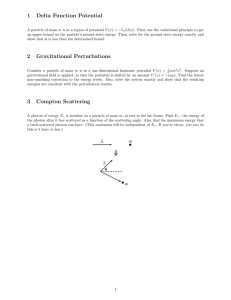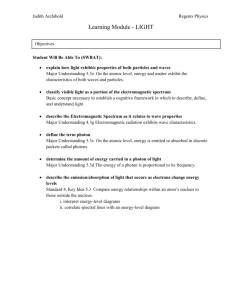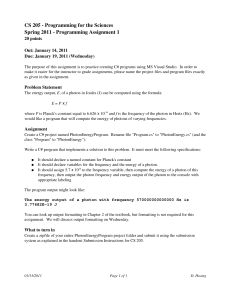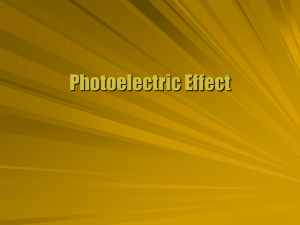Particle Interactions Heisenberg Uncertainty Principle
advertisement
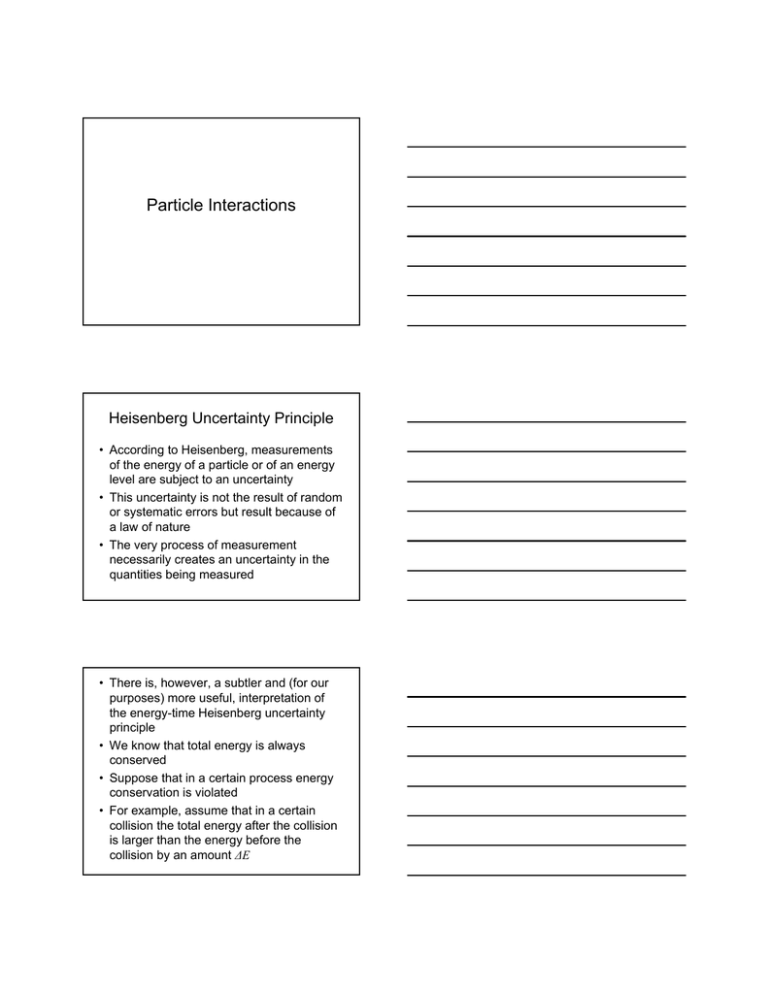
Particle Interactions Heisenberg Uncertainty Principle • According to Heisenberg, measurements of the energy of a particle or of an energy level are subject to an uncertainty • This uncertainty is not the result of random or systematic errors but result because of a law of nature • The very process of measurement necessarily creates an uncertainty in the quantities being measured • There is, however, a subtler and (for our purposes) more useful, interpretation of the energy-time Heisenberg uncertainty principle • We know that total energy is always conserved • Suppose that in a certain process energy conservation is violated • For example, assume that in a certain collision the total energy after the collision is larger than the energy before the collision by an amount ΔE • The Heisenberg uncertainty principle claims that this is in fact possible!!! – Provided the process does not last longer than a time interval given by t h 4E • In other words, energy conservation can be violated provided the time it takes for that to happen is not too long Virtual Particles • Let us consider the possibility of a free electron emitting a photon • This process actually violates the law of conservation of energy • It cannot take place unless the photon that is emitted is very quickly absorbed by something else so that the energy violation (and the photon) becomes undetectable • Because this photon violates energy conservation, it is called a virtual photon • This process is impossible according to classical physics but is possible within quantum theory • This process is represented by the following diagram (called a Feynman diagram) • Consider the following diagram: • Because the first electron emitted a photon, it changed direction a bit to conserve momentum • Similarly, the second electron also changed direction, since it absorbed a photon • Looked at from a large distance away, the change in direction of the two electrons can be interpreted as the result of a force or interactions between the two electrons – Repelling forces due to Coulomb’s law • The particle physics view is that Coulomb’s law (electromagnetic force) is the exchange of a virtual photon between the electrons – The exchanged photon is not observable Basic Interactions Interaction Interaction acts on Electromagnetic Particles with electric charge Weak Quarks and leptons only Strong (color) Quarks only W and Z bosons Gluons 1 Gravitational Graviton 10-38 Particles with mass Exchange Relative particle(s) strength Photon 137-1 10-6 • Since the early 1970s the electromagnetic and weak nuclear interactions have been shown to be two faces of the same interaction – Electroweak interaction • So there are really three fundamental interactions: – The electroweak interaction – The strong (color) interaction – The gravitational interaction Some Interaction Vertices Feynman Diagrams • Feynman diagrams can be used to calculate the probability of a process actually taking place • The vertices in the diagram represent a definite mathematical expression called the amplitude of the process • The square of the amplitude gives the probability of the process actually taking place • A value called the strength of the interaction is applied to each vertex • For the electromagnetic interaction, the basic vertex is assigned the value EM 1 where EM 137 • The amplitude of the diagram is the product of the values for each vertex Example • This process has two interaction vertices, so the amplitude of the diagram is proportional to EM EM EM Example • All of these processes have four interaction vertices, so the amplitude for these is proportional to 2 EM EM EM EM EM Building Feynman Diagrams • Using the basic interaction vertex for the electromagnetic interaction, we can build up complicated processes • All we need are the following ingredients: – The basic interaction vertex – Lines with arrows to represent electrons and positrons – Wavy lines to represent photons Example • Photon scattering off another photon 2 Amplitude EM Weak Interaction • Weak interactions involve the W and Z bosons along with two fermions Examples • β- decay Strong (color) Interaction • Strong (color) interaction is complex • One vertex is similar to the electromagnetic interaction – Except that it involves quarks and gluons • There are also interactions that just involve gluons Example • A red u quark becomes a blue u quark Range of Interaction • Consider the following interaction in which two particles interact by the exchange of some particle with mass m • The fastest that the virtual particle can travel is the speed of light, c • The time to reach the other particle will be Rc • The energy exchanged will be mc2 • Taking the uncertainties to be of the order of the values we have by the Heisenberg uncertainty principle mc 2 R h c 4 R h 4mc • This explains why the electromagnetic force has an infinite range – Mass of photon is zero, therefore the range is infinite • This also explains why the weak reaction has a short range – W and Z bosons have a large mass – W has a mass of about 80 GeVc-2
